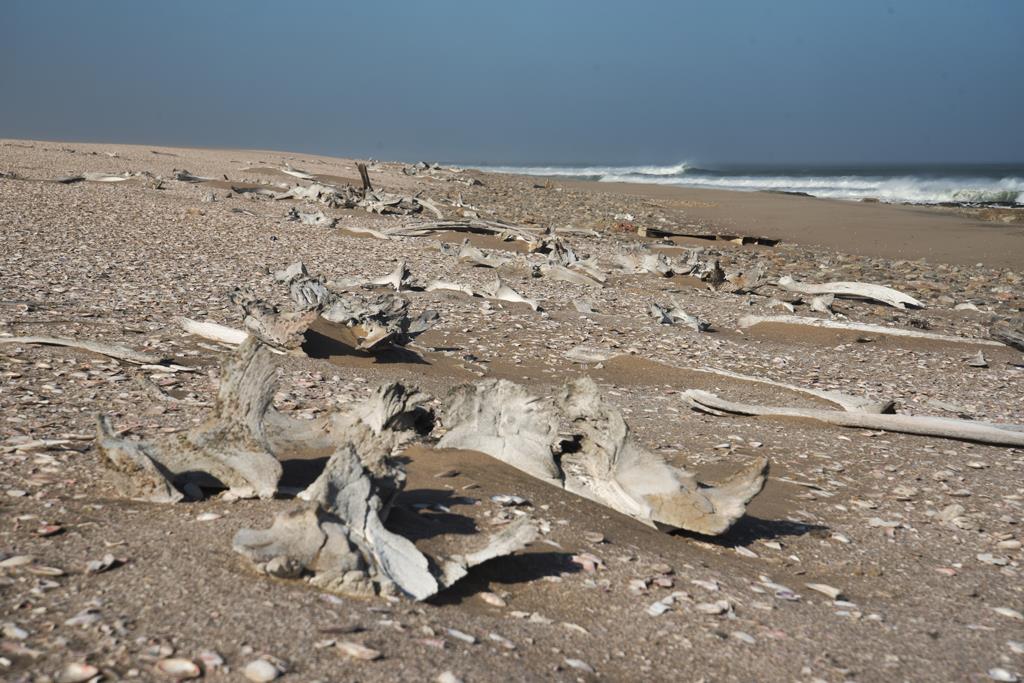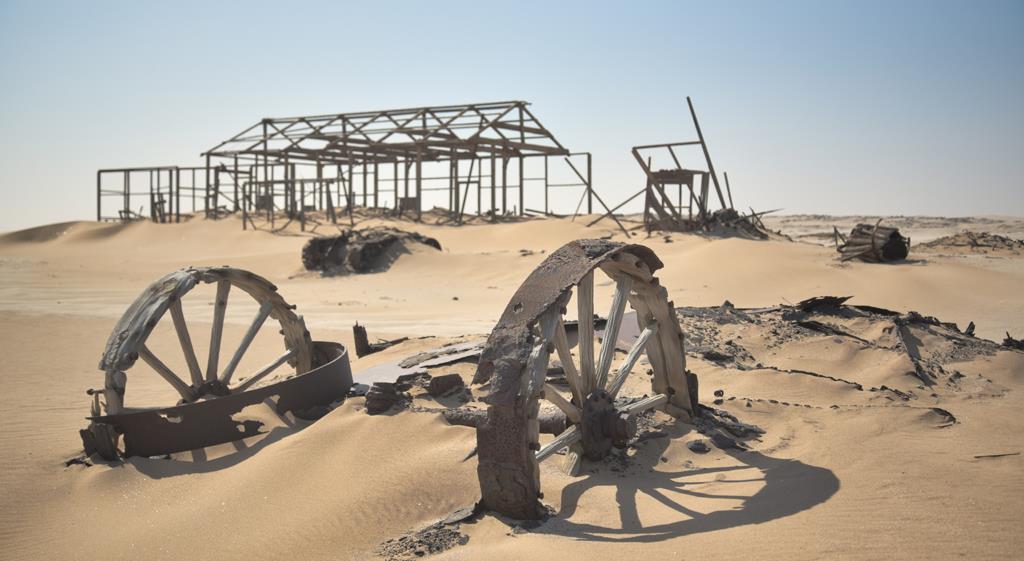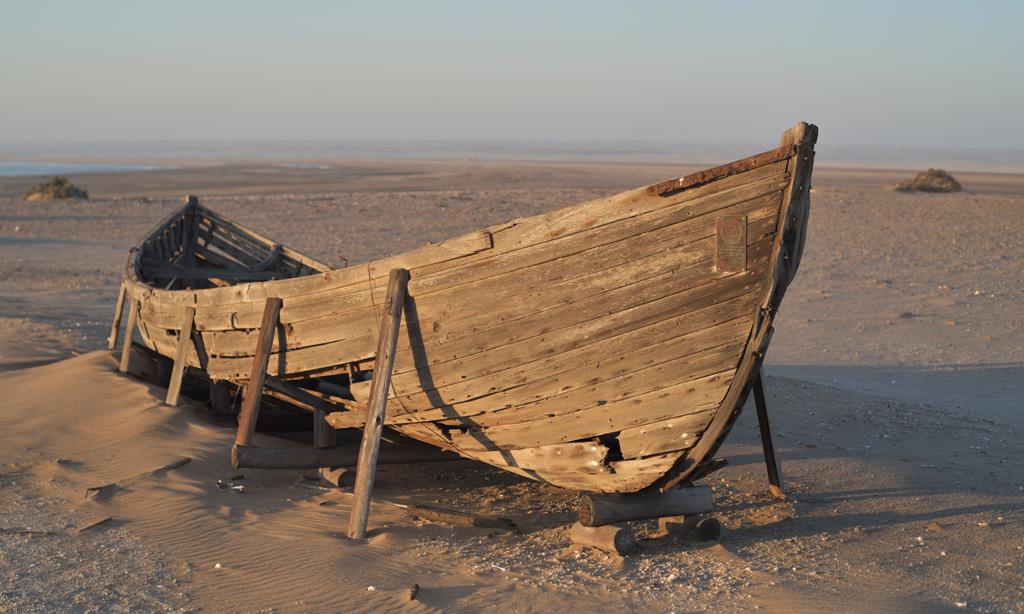Discovering Shipwrecks & Diamonds (Part 2)
A 4X4 tour in Namibia’s remote Sand Sea
By Erwin Leuschner
It’s an early start. As luck would have it, the east wind is howling, with the canvass tent’s windows starting to flap at 3 in the morning.
“This is somewhat unusual,” says Theunis while we sit at the large table eating our good ol’ farmer’s breakfast. “Still, this weather gives a perfect glimpse into the hardships the diamond pioneers of yesteryear had to endure,” he adds.
Shortly after my second cup of coffee, I find myself again sitting in our trusty Land Cruiser. There is a lot of driving on this tour.
For the first few kilometers we double back north. When we drove past Meob Bay yesterday at dusk, I barely made out the large pieces littering the beach. Now it is quite clear: Whale bones are strewn for miles and miles. “Long ago there used to be a whaling station on Hollam’s Bird Island,” our guide says, pointing to the horizon. The bones are a stark reminder of humanity’s brutalities.
At Meob Bay we stop at an old wooden shack. The door is closed and the hinges screech as our driver Len Kooitje opens it. Turns out Meob Bay was used as a harbour to offload mining equipment and personnel during the diamond rush between 1890 and 1914. The house we are standing in served as office and accommodation for the transport manager of the Namaqua Diamond Company. It’s the last hut still standing to this day, thanks to the Windhoek Underwater Club and National Heritage Council who preserve these historic artifacts.
Fascinating artifacts left behind close to 100 years ago, fill the inside.
Next to the hut are two surfboats used to transport goods and passengers from ship to shore. They were apparently manned by Liberians who were unbeatable masters at steering them in the rough Atlantic Ocean. One surfboat is renovated regularly; only the bare bones of the other remains.
“In a few years’ time there probably won’t be anything left anymore,” Theunis says, adding: “That is why we offer this tour. We want to share this history before it disappears entirely.”
I couldn’t agree more.
Next stop is Grillenberger. It’s an odd name for the first diamond town we visit, located about 25 kilometers inland. Our jaws drop. After the proclamation of the Sperrgebiet in the south, diamond prospectors turned north and discovering gems at Spencer Bay as well as between Meob and Conception Bay. The mining settlements Holsatia, Charlottenfelder and Grillenberger were established in the 1920s. Grillenberger was the largest and included an impressive workshop, a store, a small field hospital with 20 beds, a slaughter house, a police station and post office, and telephone communication(!) - and it’s literally located in the middle of nowhere.
Conditions in the desert were harsh, to put it mildly. There were no engines and everything was transported using ox wagons. One such wagon stands in the desert between Grillenberger and Charlottenfelder.
While Grillenberger was the largest settlement, most workers lived at Charlottenfelder and Holsatia were so-called A-frame huts were erected. The mining settlements were completely abandoned in the 1930s and everybody had to leave within hours, leaving their belongings behind to weather away. What used to be a big mining operation, is now deteriorating rapidly.
What a pity.
“Are there still diamonds here?” we ask our guide Len. “Yes,” he answers without hesitating. “A few years back, comprehensive prospecting took place and diamonds were indeed found. But as there is no infrastructure here, mining operations are not feasible,” he says. We all look down and hope to spot something sparkling in the soft sand.
Nothing. Probably better this way.
As the sun begins to set and after a quick visit to Fischersbrunn where fresh water was available, we find ourselves on a dune close to our camp at Meob Bay. Here we are treated to fresh oysters, sparkling wine and an amazing sundowner.
After dinner at camp, we literally pass out in our beds.
Today we witnessed a fascinating part of Namibia’s history, which you won’t learn about in school. “Shipwrecks & Diamonds” is indeed a fitting name for this adventure. Tomorrow, we are told, we can catch our dinner. The adventure continues!
e diamond rush - including this bookcase, which is filled with historic volumes.
It’s an early start. As luck would have it, the east wind is howling, with the canvass tent’s windows starting to flap at 3 in the morning.
“This is somewhat unusual,” says Theunis while we sit at the large table eating our good ol’ farmer’s breakfast. “Still, this weather gives a perfect glimpse into the hardships the diamond pioneers of yesteryear had to endure,” he adds.
Shortly after my second cup of coffee, I find myself again sitting in our trusty Land Cruiser. There is a lot of driving on this tour.
For the first few kilometers we double back north. When we drove past Meob Bay yesterday at dusk, I barely made out the large pieces littering the beach. Now it is quite clear: Whale bones are strewn for miles and miles. “Long ago there used to be a whaling station on Hollam’s Bird Island,” our guide says, pointing to the horizon. The bones are a stark reminder of humanity’s brutalities.
At Meob Bay we stop at an old wooden shack. The door is closed and the hinges screech as our driver Len Kooitje opens it. Turns out Meob Bay was used as a harbour to offload mining equipment and personnel during the diamond rush between 1890 and 1914. The house we are standing in served as office and accommodation for the transport manager of the Namaqua Diamond Company. It’s the last hut still standing to this day, thanks to the Windhoek Underwater Club and National Heritage Council who preserve these historic artifacts.
Fascinating artifacts left behind close to 100 years ago, fill the inside.
Next to the hut are two surfboats used to transport goods and passengers from ship to shore. They were apparently manned by Liberians who were unbeatable masters at steering them in the rough Atlantic Ocean. One surfboat is renovated regularly; only the bare bones of the other remains.
“In a few years’ time there probably won’t be anything left anymore,” Theunis says, adding: “That is why we offer this tour. We want to share this history before it disappears entirely.”
I couldn’t agree more.
Next stop is Grillenberger. It’s an odd name for the first diamond town we visit, located about 25 kilometers inland. Our jaws drop. After the proclamation of the Sperrgebiet in the south, diamond prospectors turned north and discovering gems at Spencer Bay as well as between Meob and Conception Bay. The mining settlements Holsatia, Charlottenfelder and Grillenberger were established in the 1920s. Grillenberger was the largest and included an impressive workshop, a store, a small field hospital with 20 beds, a slaughter house, a police station and post office, and telephone communication(!) - and it’s literally located in the middle of nowhere.
Conditions in the desert were harsh, to put it mildly. There were no engines and everything was transported using ox wagons. One such wagon stands in the desert between Grillenberger and Charlottenfelder.
While Grillenberger was the largest settlement, most workers lived at Charlottenfelder and Holsatia were so-called A-frame huts were erected. The mining settlements were completely abandoned in the 1930s and everybody had to leave within hours, leaving their belongings behind to weather away. What used to be a big mining operation, is now deteriorating rapidly.
What a pity.
“Are there still diamonds here?” we ask our guide Len. “Yes,” he answers without hesitating. “A few years back, comprehensive prospecting took place and diamonds were indeed found. But as there is no infrastructure here, mining operations are not feasible,” he says. We all look down and hope to spot something sparkling in the soft sand.
Nothing. Probably better this way.
As the sun begins to set and after a quick visit to Fischersbrunn where fresh water was available, we find ourselves on a dune close to our camp at Meob Bay. Here we are treated to fresh oysters, sparkling wine and an amazing sundowner.
After dinner at camp, we literally pass out in our beds.
Today we witnessed a fascinating part of Namibia’s history, which you won’t learn about in school. “Shipwrecks & Diamonds” is indeed a fitting name for this adventure. Tomorrow, we are told, we can catch our dinner. The adventure continues!
e diamond rush - including this bookcase, which is filled with historic volumes.










Kommentar
Allgemeine Zeitung
Zu diesem Artikel wurden keine Kommentare hinterlassen